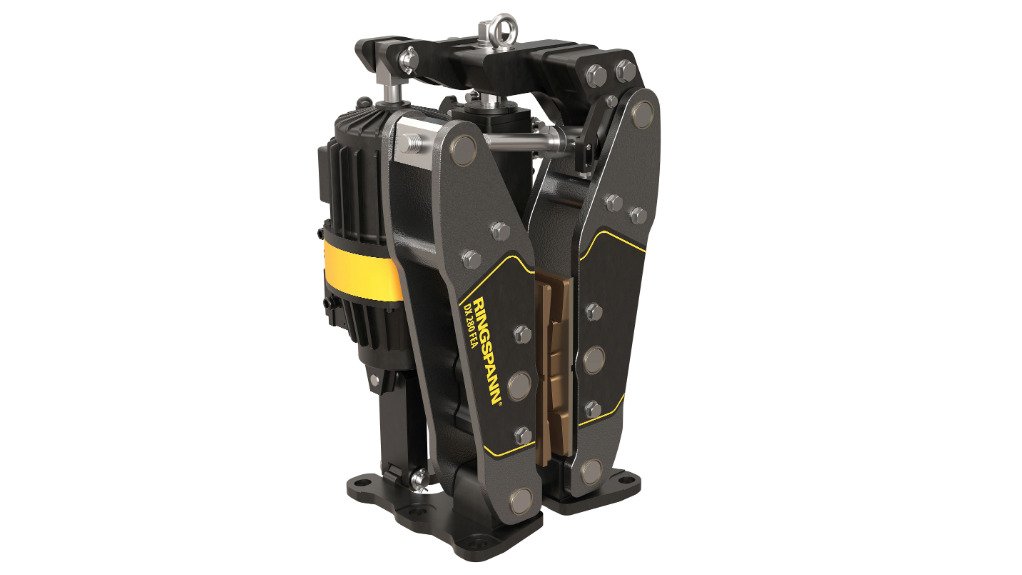New standards and efficiencies are being reached in harbour crane technologies, owing to the re-engineering of the DX series’ electrohydraulic disc brakes, developed by couplings and freewheel manufacturer RINGSPANN.
The DX series is engineered and manufactured in Bad Homburg, Germany, notes RINGSPANN brakes business developer Martin Ohler. There has been a significant increase in demand for the series among harbour crane hoist manufacturers since its deployment in December.
“The DX series’ electrohydraulic disc brakes are crucial in the operation of holding and emergency stop systems for heavy duty and container crane hoists.”
The DX brake is mounted on the motor’s output shaft, ensuring that it directly controls the rotation of the drive system, he adds.
When the drive is operational, the thruster is activated by the hydraulic system, opening the brake; however, when power is lost or the system is commanded to stop, the hydraulic pressure is released, and the spring-loaded brake engages, stopping the drive.
Designed for a high number of switching cycles on fast-rotating discs, in addition to being equipped with new design angle levers and energy efficient electrohydraulic thrusters, the DX Series offers substantial added value in the design of the hoists, as well as their operation and ease of maintenance.
Delivering on a New Design
RINGSPANN has delivered on orders from the manufacturers and harbour crane operators that attended the launch of the DX series last year.
Ohler attributes the high acceptance of the series and its electrohydraulic brakes to their being a convincing solution in “every respect” for the implementation of assembly-, user- and service-friendly holding and emergency stop systems for the crane hoists.
“There are three factors that prove these disc brakes’ credentials as an innovative solution: the substitution of numerous cast components with components made of flame-cut steel, the redesign of the angle lever and the use of a new type of electrohydraulic thruster.”
The new brakes’ compact dimensions are also “striking”, he adds.
Owing to their compact design and the mounting dimensions of the base plate, the brakes can be easily integrated into existing crane and hoist solutions and can replace other models without modifications.
The steps RINGSPANN engineers have implemented in the fundamental revision of the DX series disc brakes include the design of important components – such as the brake lever – in steel only, producing several advantages.
The new design results in a slimmer brake and a low unit price, while maintenance, servicing and general overhaul is significantly reduced.
Further, the new design of the angle lever also offers decisive advantages, such as a functional connection between the electrohydraulic thruster, brake spring and brake levers, as the angle lever must absorb bending and torsional forces.
However, to ensure that these forces do not have a negative effect on the brake levers and bushings, the company has recalculated the angle lever and designed it to have the same high torsional rigidity as a traditional cast-iron solution.
“Importantly, the new angle lever comprises only a few parts, which is why it is easy to install and replace,” Ohler avers.
Electrohydraulic Thrusters
RINGSPANN has also achieved success through the addition of new electrohydraulic thrusters to its portfolio.
The thrusters are tailor-made for use in demanding crane technology applications, such as main hoists and trolleys, and generate lifting forces of up to 8 kN and score well in terms of closing times, at less than 80 milliseconds.
The thrusters use a gear pump to generate pressure, and the layout is 100% analogue; therefore, no circuit board is required. They are also fitted with a regular three-phase connection.
“In addition, they impress with their high energy efficiency because when the brake is open, power consumption is very low, owing to pressure-less circulation operation,” lauds Ohler.
The installation of the thrusters contributes to the compact design of the brake, and its easy maintenance “should please every crane operator”.
Ohler points out that wearing parts, such as solenoids, can be replaced while the thruster is installed in the brake.
“The last few weeks have shown us that we are on the right track with the re-engineering of our DX disc brakes,” he concludes. ![]()







